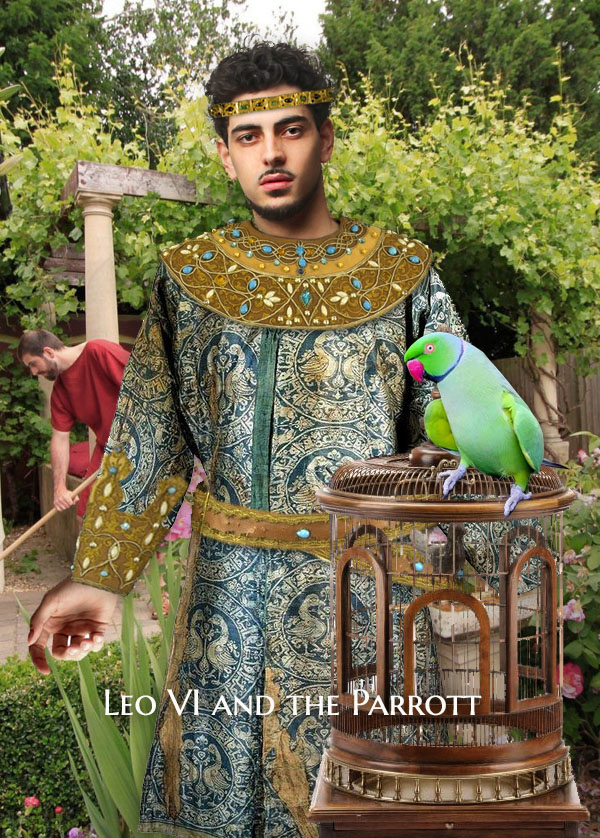 Leo VI was called the Wise for his completion of the compilation of a great law code in Greek for the empire, called the Basilika. He was the second son of the previous emperor, Basil I and Eudokia Ingerina. Leo was actually the son of the precious emperor Michael the Drunkard, which is a long story best told in its own page. Basil knew Leo was not his son; Leo also knew who his real father was.. As result, Basil treated him badly; he favored his first, natural son, Constantine, over Leo. Even though Basil had Constantine and Leo crowned as co-emperors, he excluded Leo from any role in government or the military. He finally shut Leo up in captivity within the palace grounds.
Leo VI was called the Wise for his completion of the compilation of a great law code in Greek for the empire, called the Basilika. He was the second son of the previous emperor, Basil I and Eudokia Ingerina. Leo was actually the son of the precious emperor Michael the Drunkard, which is a long story best told in its own page. Basil knew Leo was not his son; Leo also knew who his real father was.. As result, Basil treated him badly; he favored his first, natural son, Constantine, over Leo. Even though Basil had Constantine and Leo crowned as co-emperors, he excluded Leo from any role in government or the military. He finally shut Leo up in captivity within the palace grounds.
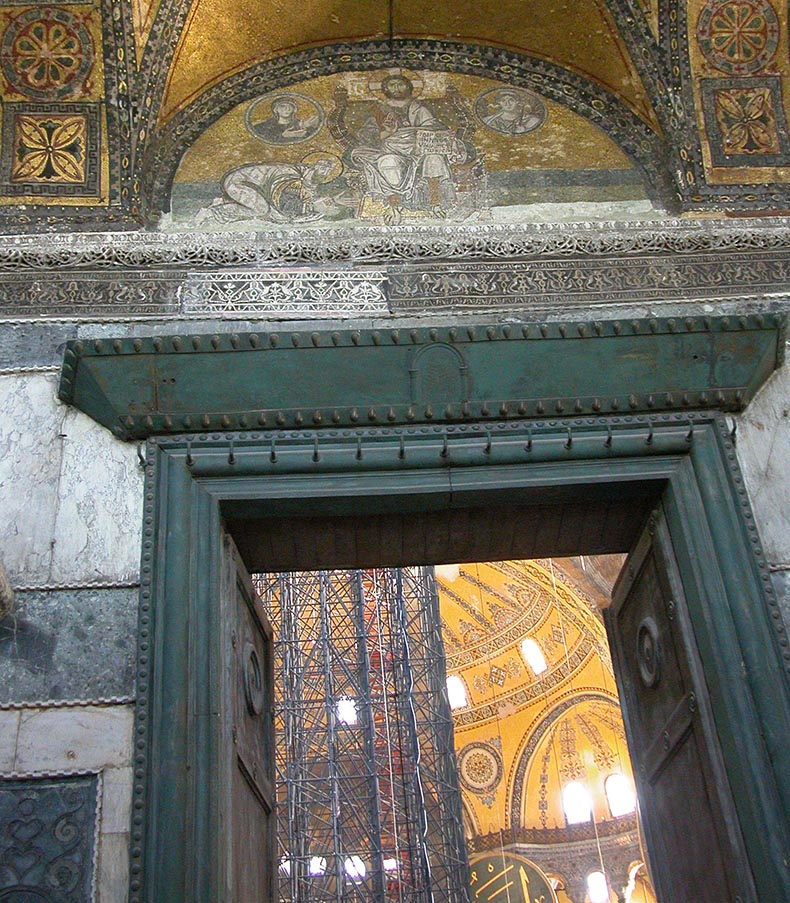 Alas for Basil, his favorite Constantine died and he was compelled to release Leo from prison due to public pressure and a guilty conscience. Basil was hosting a banquet in the palace for a group of senators. During the dinner a palace parrot - a favorite and very popular bird - who had been kept in a cage near Basil started screeching "Poor Leo, Poor Leo, let him go", over and over again! No one knew where the parrot learned to say it and his words were considered an omen. The senators pleaded with Basil to take pity on Leo. Basil released Leo in June and three months later in, September 866, Basil was dead! Happy Leo, poor Basil. There is no record of what happened to the parrot, one can hope Leo rewarded him for his intervention on Leo's behalf when he became sole emperor. Below is a manuscript illustration of the incident of the parrot, probably a green Indian ringneck parakeet, which was very popular in Byzantium as a pet. They were recognized for their ability to clearly mimic human language were admired for their colors and charming disposition, but the church discouraged excessive attention being given to pets like birds. Clement of Alexandria rebuked people who kept parrots, apes, and peacocks to amuse them at dinner, instead of providing for the poor. On can only imagine Imperial dinners with apes!
Alas for Basil, his favorite Constantine died and he was compelled to release Leo from prison due to public pressure and a guilty conscience. Basil was hosting a banquet in the palace for a group of senators. During the dinner a palace parrot - a favorite and very popular bird - who had been kept in a cage near Basil started screeching "Poor Leo, Poor Leo, let him go", over and over again! No one knew where the parrot learned to say it and his words were considered an omen. The senators pleaded with Basil to take pity on Leo. Basil released Leo in June and three months later in, September 866, Basil was dead! Happy Leo, poor Basil. There is no record of what happened to the parrot, one can hope Leo rewarded him for his intervention on Leo's behalf when he became sole emperor. Below is a manuscript illustration of the incident of the parrot, probably a green Indian ringneck parakeet, which was very popular in Byzantium as a pet. They were recognized for their ability to clearly mimic human language were admired for their colors and charming disposition, but the church discouraged excessive attention being given to pets like birds. Clement of Alexandria rebuked people who kept parrots, apes, and peacocks to amuse them at dinner, instead of providing for the poor. On can only imagine Imperial dinners with apes!
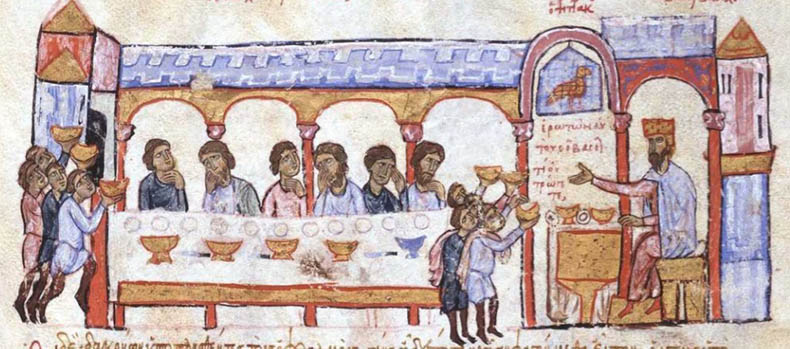
In the same year Leo had his eunuch brother, the 19 year old Stephen, made Patriarch. He served for seven years and seems to have been a pious, if ridiculously youthful prelate. Leo deposed the scholar-patriarch Photius when he had his brother elevated. Photios had been Leo's tutor and Leo had no love for him. Photius later became a saint in the Orthodox church.
Leo had been married when he was 16 to Theopano, a beautiful but highly religious and frigid girl. She had been selected by his mother in a bridal competition among potential girls. Leo hated Theopano. When his mother died he took up publicly with a mistress, Zoe Zaoutzaina. Through a series of marriages that ended in deaths he had a son with another mistress named, Zoe - whose nickname was Dark Eyes. She bore him a son - his first surviving boy - and this began Leo's campaign to having his marriage to Zoe recognized by the church and his son made his heir.
Leo had a very bad relationship with the church. He considered himself a great theologian and preacher and personally delivered sermons in church. He took Muslim ambassadors through Hagia Sophia and order the clergy to show them the sacred vestments, vessels and crosses from the Treasury. The Muslim ambassadors had come from the Emirate of Tarsus. The son of the emir was with them. There was talk that the emir was considering converting to Christianity and he was given a grand tour of Hagia Sophia in order to impress him with the superiority of the Christian faith. Choirs were chanting and fragrant incense was burnt to enhance the other-worldliness of the church. The church had been decorated with garlands of flowers and the floors were strewn with fragrant rosemary, myrtle and grape leaves and it had been washed with rosewater. The emir's son was forced to return to his father and did not convert. Below is an illustration of Leo VI showing the sacred treasures to the Muslim visitors in Hagia Sophia.
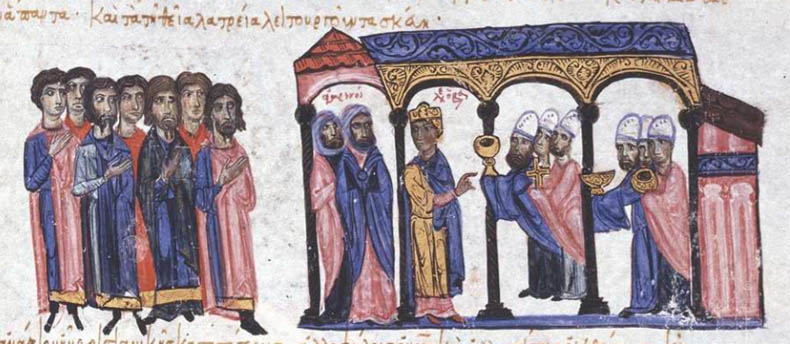
Leo found a priest who married him to Zoe Karbonopsina "Dark Eyes". When the church resisted his pressure to recognize this forth marriage Leo went around the back of the Patriarch and negotiated with the Pope in Rome. The Roman church recognized forth marriages as long as the previous spouses were all dead, which was the case with Leo. On two occasions (Christmas 906 and Epiphany, 6 January 907) the emperor arrived in procession with the senate at this very door - only to be denied entry by the Patriarch Nicholas for his forth illegal marriage to Zoe Karbonopsina. For this he was compelled to make penance for the sin of marrying too many times. In the mosaic you can see Leo prostrated before Christ. During his penance, although he was forbidden to enter the nave of the church, Leo was allowed to enter the Hagia Sophia through the right aisle to walk to the private Imperial Metatorian at the end of the aisle where he could watch and listen to the liturgy in disgrace. In time the crisis was resolved and Leo was allowed to enter the nave again and receive the sacrament.
The church never really forgave Leo. He deposed the patriarch who had opposed his forth marriage, Nicholas Mysticus, and replaced him with Euthymius. Leo died in 912, only 45 years old, and Euthymius was deposed, Nicholas, returned to the patriarchal throne and became regent to Leo's now six year old son.
Hagia Sophia was a patriarchal church, it did not belong to the emperor and any changes or additions to it were ordered by church authorities. This mosaic was ordered by Nicholas Mysticus and executed by church artists. Leo was gone and could do nothing to stop it. It was intended to be a permanent warning to future emperors that Christ and his church had authority over all men, regardless of their position. Nicholas took further revenge on Leo by omitting his name from the mosaic, robbing him of his name and title. Leo had done the same thing to Nicholas when he had him deposed and his name erased from the lists of Patriarchs, now the tables were reversed. Now, over a thousand years later, Leo continues to grovel before Christ and the Archangel Michael for mercy and forgiveness! I believe the mosaic of Justinian and Constantine in the South Vestibule was ordered by Nicholas as a part of the same redecoration of Hagia Sophia and is meant to contrast good emperors with a bad one.
Leo's brother Alexander was his co-emperor. They hated one another. When Leo died Alexander continued as co-emperor with Leo's son Constantine. His mosaic portrait (probably also ordered by Nicholas Mysticus) can still be seen in the North Gallery of the church. You can see it by clicking here.
The center door was called the Royal Door and only the Emperor could pass through it on special days. At the ritual entrance of the Emperor to Hagia Sophia, holding a large candle, he would bow three times before this door, while choirs chanted. It's huge and massive planks were said to be wood from Noah's Ark, a story first recorded in the 9th century. The Partia Constantinopoleos informs us: “In the second narthex the doors were made of ivory (three to the right, three to the left, and between them) three other doors: two of the middle size, and between them there was the very big one of gilded silver. All the doors were gilded. Inside these doors instead of normal wood there was the Wood of the Ark”
As described in the Partia the door was covered by sheets of silver-gilt. It was secured by a big and impressive silver lock. In Byzantine times the door was also known as the Silver Gates as well as the Beautiful Gates. On either side of the door hung an icon of the Savior and one Mary of Egypt and the Theotokos, brought here from the Holy Sepulchre in Jerusalem. Markings 7ft from the floor show where the icons were placed. The door was also known as Door of Repentance, above in the arch is the mosaic of the Byzantine Emperor Leo the Wise.
The door has a brass frame that dates from either the 6th century or the ninth century. Based on the style of the text, most recent scholarship supports a later date. Along the top are a series of hooks in the shape of fingers The brass has the same fine ornamentation in its borders as the other doors in Hagia Sophia. I don't know if the brass frame was ever gilded. I think not, since the only gilding method that could be oil based one. Brass can be kept polished to a very fine gold-like finish, let's assume that's what was done. The Byzantines considered it a low-cost alternative to gold. All of the so-called bronze Byzantine doors - like in Saint Mark's in Venice and the others in Hagia Sophia - are actually brass.
Anyone who wanted to enter Hagia Sophia had to have recently been to confession to be ritually pure. If you could not find a priest you could confess your sins to the icon of Christ and receive forgiveness through Him. In 1453, when the Muslim army hacked its way into Hagia Sophia it is unlikely they could have battered this door down. It was still probably covered in metal plates and the wood was too thick. So is the wood the original wood? I don't know. All of the silver was robbed in 1204 during the looting of Hagia Sophia by the Crusaders. We don't know for sure how much of the precious revetment of the door was restored in silver after the reconquest of the city in 1261. The icons were back with silver-gilt ornament. In the redecoration of the church by Michael VIII and his son Andronikos II they would have tried to recreate as much of the sumptuous decoration of Hagia Sophia, but the scale of the work would have limited their ability to lavish precious materials on doors. Most of their money would have been concentrated on the sanctuary with its altar, ciborium, chancel screen, solea and ambo. Below is a diagram of the location of the mosaic drawn by Robert Van Nice.
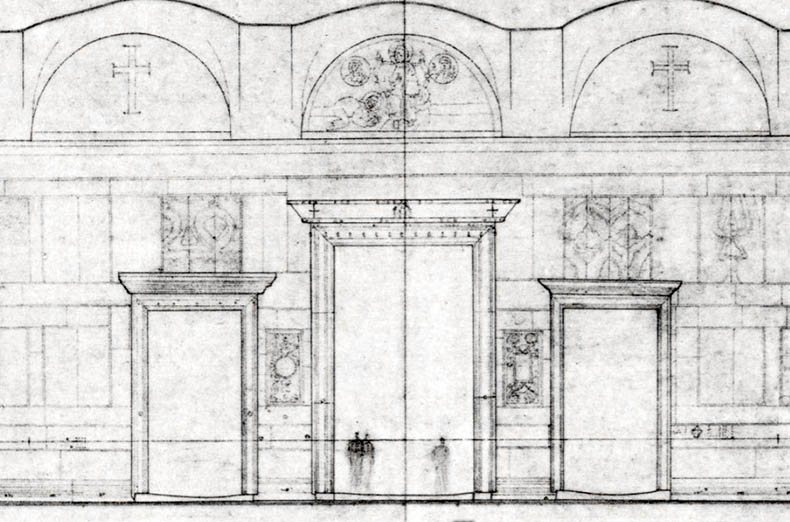 In 1959 and 1960 further cleaning was done on the mosaic over the Imperial Door, the great doorway leading from the narthex into the nave, of St. Sophia at Istanbul. This completed the work done in 1931-1932 which, as Thomas Whittemore reported, left the mosaic somewhat obscured by plaster remaining from its having been covered, in 1847-1849, under the direction of the Fossati brothers. The removal of this nineteenth-century plaster, and of some paint also on the surface, has allowed for more precise observations of the panel which revealed details of the mosaic, such as the feet of Christ, the finial on the left-hand side of the horizontal bar across the back of the throne, the knot on the right-hand side of the cushion, asymmetrical arrangement of the cross of pearls on the Emperor's crown, and an inserted inscription. It is now possible to make a restatement of the materials and colors employed and thus to explain the present pallid appearance of the faces of the Virgin and the Archangel in the medallions, to clarify the design at the central part of the drapery where the robes of Christ have been confused with the fabric of the cushion, and to confirm the statements of Salzenberg and Labarte that the buskins of the Emperor were red.
In 1959 and 1960 further cleaning was done on the mosaic over the Imperial Door, the great doorway leading from the narthex into the nave, of St. Sophia at Istanbul. This completed the work done in 1931-1932 which, as Thomas Whittemore reported, left the mosaic somewhat obscured by plaster remaining from its having been covered, in 1847-1849, under the direction of the Fossati brothers. The removal of this nineteenth-century plaster, and of some paint also on the surface, has allowed for more precise observations of the panel which revealed details of the mosaic, such as the feet of Christ, the finial on the left-hand side of the horizontal bar across the back of the throne, the knot on the right-hand side of the cushion, asymmetrical arrangement of the cross of pearls on the Emperor's crown, and an inserted inscription. It is now possible to make a restatement of the materials and colors employed and thus to explain the present pallid appearance of the faces of the Virgin and the Archangel in the medallions, to clarify the design at the central part of the drapery where the robes of Christ have been confused with the fabric of the cushion, and to confirm the statements of Salzenberg and Labarte that the buskins of the Emperor were red.
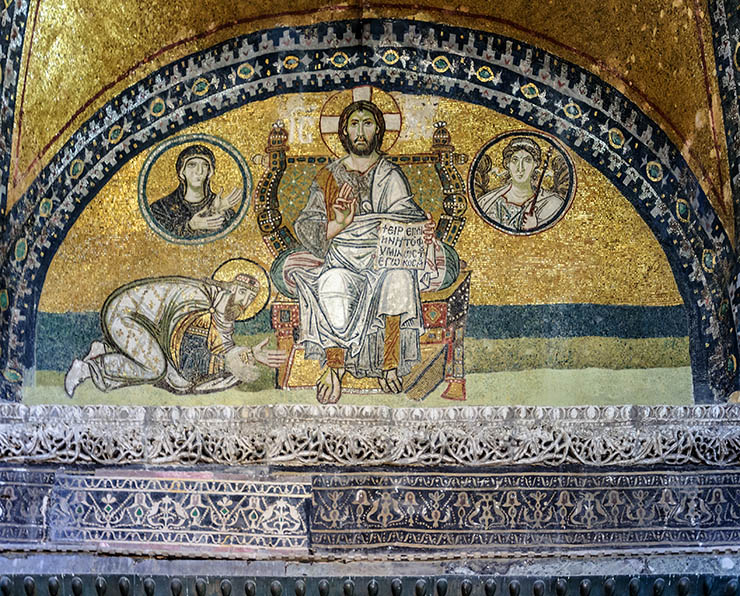
The existing mosaic of the lunette replaced an earlier panel which was completely removed from within the encircling border down to the top of the original vine-leaf panels which formed the cornice below. The earlier mosaic presumably contained a cross similar to those in the other compartments through-out the narthex which without doubt were part of the original decoration of the time of Justinian. There is no evidence of any work of an intermediate period either in this central lunette or elsewhere in the narthex, and speculations that these mosaic crosses or those in the aisles might be of the iconoclastic period are untenable, because this would imply that the entire building was denuded at that time of every piece of original mosaic and completely redecorated without a trace of the earlier mosaic surviving or indeed any evidence that such an operation took place.
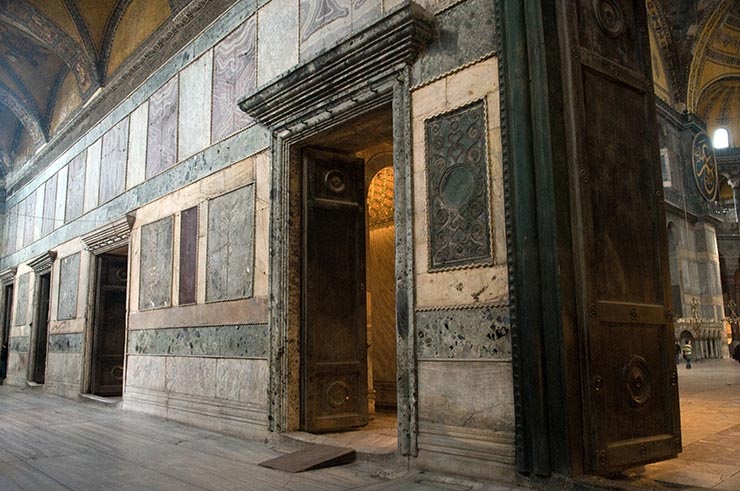
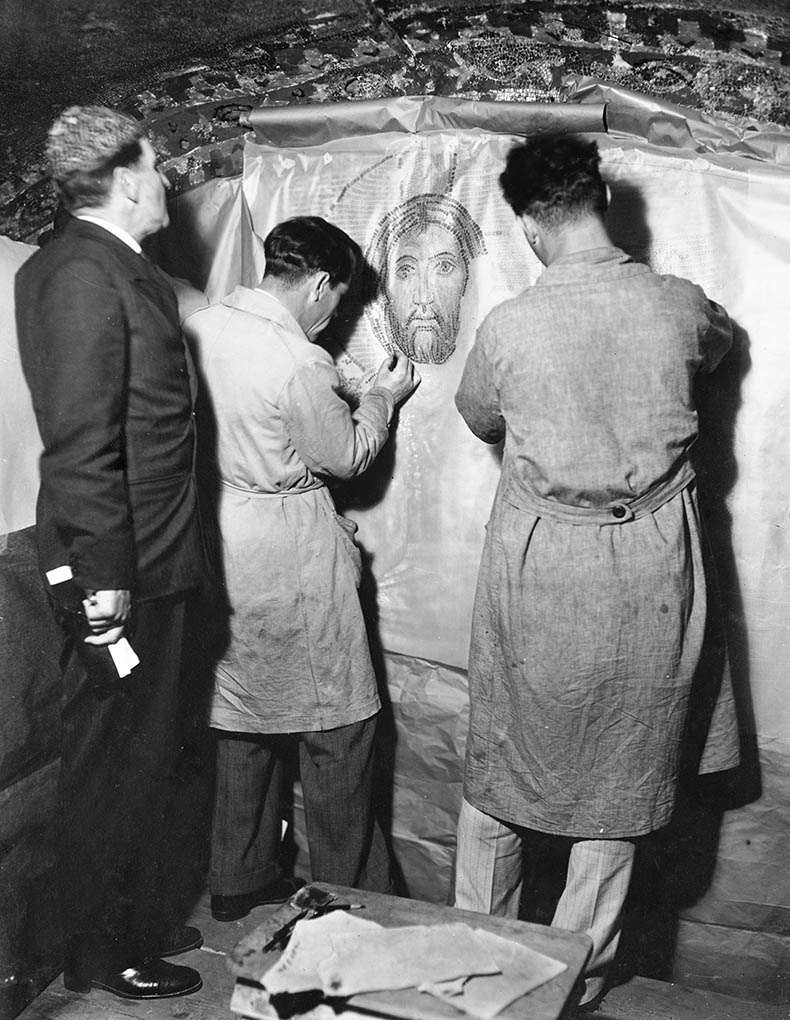 The image above shows restoration artists taking a tracing of the Leo mosaic in preparation for the creation of a traveling replica. That's Thomas Whittemore looking on from the back.
The image above shows restoration artists taking a tracing of the Leo mosaic in preparation for the creation of a traveling replica. That's Thomas Whittemore looking on from the back.
COLOR CHART OF TESSARAE
Metal
1. Gold
2. Silver
Glass
3. Deep red. This frequently has dark purple-brown streaks which only exceptionally were selected for use as a separate color.
4. Bright red. Referred to as orange-vermilion in this description to differentiate it from the pigment of No. 34, to which it is very close in color.
5. Yellow. A greenish yellow close to light chrom
6. Yellow-green
7. Pale green
8. Light green
9. Leaf green. An emerald color
10. Blue-green. A dark viridian
11. Turquoise blue. Of several tones, but not used separately as individual values in this mosaic.
12-16. Blue. Close to dull ultramarine; used in five values from pale to dark blue.
17. Blue-black
18. Purple-black
19-21. Purple. Used in three values; light, medium, and dark.
22. Light green-amber
23. Clear brown. A dark translucent glass used as a backing for gold tesserae.
24. Matte brown. The pitted underside of No. 23; usually a dark, earth red.
25. Light transparent glass. This was the type of glass used for backing silver and cannot, because of its nature, be given a closer color description.
26. Soft purple. The underside of No. 25.5
Natural Materials
27. White limestone
28. White Proconnesian marble
29. Grey Proconnesian marble
30. Blue-white marble
31. Cream marble
32. Pink marble
33. Deep pink marble
Paint
34. Red. Orange tetroxide of lead, referred to in this description as vermilion
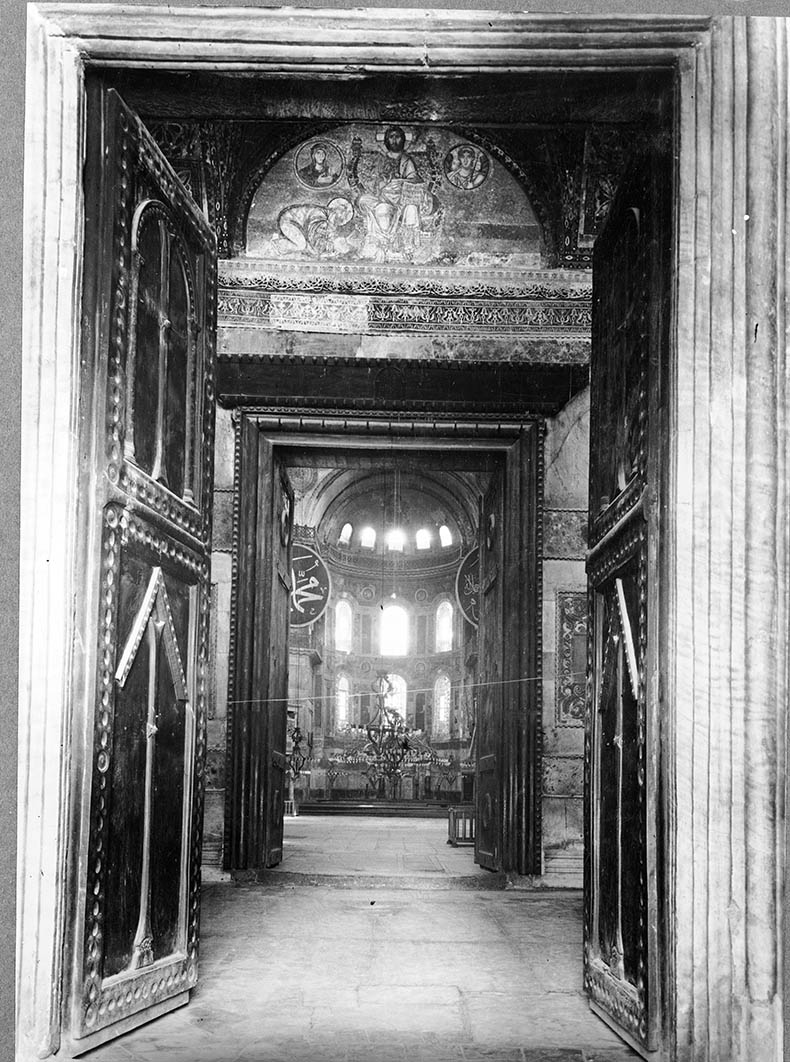
Here's a view through the Royal Doors - also called the Silver Gates -into the nave of Hagia Sophia in a picture taken soon after the restoration was complete. It is very difficult to see the mosaic within the narthex. Backing up into the outer narthex you can see it much better.
DESCRIPTION OF THE MOSAIC
The composition of the panel must by now be widely known: Christ enthroned, with two medallions, one on the left containing a bust of the Virgin and one on the right containing an archangel. The figure of an emperor is represented on the left, prostrate at the feet of Christ. These elements, with no inscription, fill the lunette rather completely except for the lower right-hand side which is occupied only by horizontal zones of green.
The background is of gold with an admixture of silver. The setting bed was frescoed with yellow ochre. There is a great variation in the proportion of silver used with the gold, which is from as much as forty per cent to as little as six per cent in one area or another. Throughout the whole panel there may be eight per cent. The silver is used most freely around the head of the emperor and to the left of the throne; this was no doubt intended to give the gold of the emperor's halo a deeper value by contrast with its immediate background. The metallic tesserae of the background are about .06 x .04 m. set generally in an upright position at angles varying from 9 to 26 degrees, most being from 9 to 15 degrees from the vertical plane. Ten rows measure, vertically, .135 m.; the distance between the rows being in some places as much as one centimeter, but these spaces are not visible when the panel is viewed from the floor. Although it is probable that the background of the earlier mosaic which this replaced was of gold set in horizontal rows, similar to those of the other vertical surfaces in the narthex, it is evident that none of this was retained. The entire earlier mosaic was removed from within the upper border where the suture between the work of the two periods can be clearly seen, even though still partly covered by Fossati's paint.
Generally, the main forms interposed upon the panel are not outlined against the background, nor are they against the grounds of the medallions, nor is the head of Christ outlined within the halo. There are, however, short outlines against the robe on the right side of the Virgin's neck and surrounding the outer line of the frame of the medallion on that side.
On the left side at the base of the lunette there are three horizontal green zones, the upper two of which are each about .20 m. high. The uppermost is a mixture of turquoise with dark blue and greens, the middle of turquoise and greens. The lowest, of light green with a few light blues, is set with tesserae only down to about .10 m. from the top. In the lower part of this zone the setting-bed was left frescoed with terra-verte. Numerous odd tesserae are scattered in all three zones; these include deep red, yellow, gold, silver, and a couple of orange-vermilion glass.
Between the emperor and the side of the throne there are only two zones; the lightest greens extend up to meet the top zone, which here is of the same mixture of turquoise and green as in the middle at the left side of the panel. On the right-hand side there are only two zones set with mosaic and below them is a band of unset plaster. Here the uppermost is turquoise with some darker blues and light greens. The middle area is of light greens and yellows with a scattering of dark blue tesserae. On the unset band along the base there are traces of the original terra-verte fresco.
When the plaster frieze below was put in place in the mid-nineteenth century, replacing the original panels representing vine leaves, plaster was spread along the top of it, sloping up to the base of the lunette upon which it encroached and partly covering the right foot of Christ. This sloping shelf of plaster has now been cut away, and the unset margin of the panel is revealed to the full extent of its survival; but the top of the frieze still extends above what was originally the bottom of the plaster margin below the mosaic.
Christ
The halo and cross are drawn in lines of single red halo is composed of horizontal rows of gold set at an angle. The horizontal arms of the cross have a row of the lower side next single green glass along to the red line and are filled with two areas of white limestone and blue-white marble. In the left arm the white is the lower area,but the area, in the lower, with the white above. Against the red line on the right of the vertical arm there is a row of green glass next to which are vertical areas of blue-white, and of white on the left.
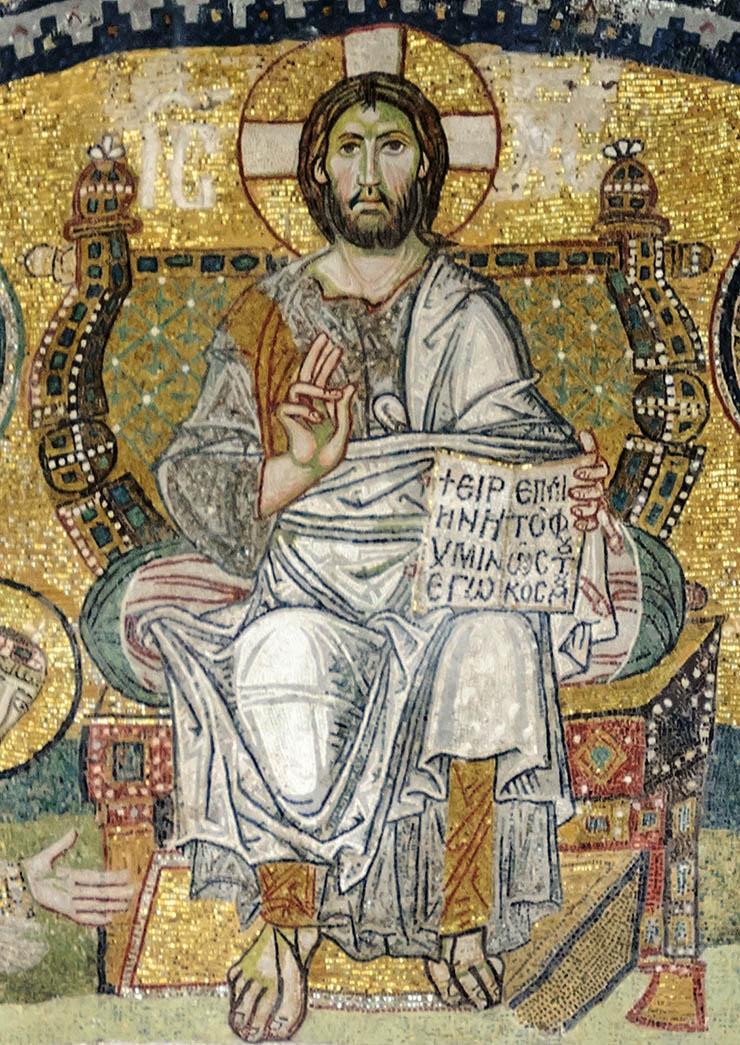 The face is unusual amongst the mosaics of St. Sophia in that it is executed in a broad manner with strong contrasting groups of green and flesh colored tesserae. At close quarters the dominant characteristics are the contrasts between the white high lights and he black shadow lines of the hair and beard, and between the red lights of the hair - echoed in the shadow lines over the eyes and in the beard below the sides of the mouth - and the bright green shading of the flesh. These strong and vivid contrasts impart a considerable feeling of projection to the features; indeed the head is conceived with a keen sense of the forward contours.
The face is unusual amongst the mosaics of St. Sophia in that it is executed in a broad manner with strong contrasting groups of green and flesh colored tesserae. At close quarters the dominant characteristics are the contrasts between the white high lights and he black shadow lines of the hair and beard, and between the red lights of the hair - echoed in the shadow lines over the eyes and in the beard below the sides of the mouth - and the bright green shading of the flesh. These strong and vivid contrasts impart a considerable feeling of projection to the features; indeed the head is conceived with a keen sense of the forward contours.
Yellow and yellow-green shading floods over the forehead, indicating three prominent forms, one over each eye and one at the center of the brow. These forms are given in pale pink lit by blue-white marble with high lights of a few white limestone tesserae on each form.
The cheeks are of blue-white, deepening in color through the three tones of pink laid in almost vertical lines sloping slightly outward and downward to points where orange-vermilion glass carries the flush of the cheeks, in a couple of short lines on each side, down to meet the beard. On the right side the face is shaded by a line of green glass on the outer edge of the form of the cheek and by a second, inner line of yellow. The other cheek is shaded by two rows of yellow glass with a few tesserae of green at the lower end of the outer line describing the under side of the cheek. The right side is darker and cool in comparison with the left, which is paler and warm.
The powerful use of red in the face is carried even into the eyes. The pupils are single purple-black tesserae; each iris is composed of a ring of small, deep red glass and a second, outer ring of purple-black. The whites are of limestone shaded on the left sides by blue-white marble. The upper lashes are single lines of purple-black and the under lashes are light purple shadowed below by light
green-amber glasses.
The eyebrows are purple-black near the bridge of the nose and light purple at the outer sides. That on the right side is lit by deep red at the angle where it recedes to the brow. The lighter shadow lines below are of yellow, and though the darker commences as light purple, the greater part of its length to the outer side is of deep red. Below the other eyebrow is a short, light green line on the outer side, a darker line of purple across the entire width which changes to deep red at the outer end, and a lower line of light green immediately above the upper lashes.
The ridge of the nose is drawn with two rows of tesserae. That on the left is of blue-white lit at the bridge, a little below the center, and at the tip by groups of two or three tesserae of white limestone. The right side is drawn with a single line of deep pink marble and the shadow line rendered by two rows of light green-amber and a row of light green, which runs down into the shadow beside the mouth. The lower contour of the tip of the nose is given by a short line of orange-vermilion glass, indicating reflected light from beneath the form. The shadows below the nostrils and above the lips are purple-black
The flesh above the lips is blue-white, shadowed at the center with the clear brown of dark translucent glass and at the sides by light green and yellow, deepening through light purple to purple-black. The upper lip is orange-ver- milion, the parting between the lips clear brown with deep red at the center, and the lower lip is of the mid-tone of pink with blue-white on the left side and orange-vermilion and yellow on the right. The shadow below is given by three horizontal rows: purple-black, pale purple, and again purple-black.
The beard is drawn in vertical strokes of light purple, shadowed and outlined by purple-black, and merging with the flesh in light green with some deep red on each side below the mouth. The contours of the beard at the sides are drawn by single lines of pale dull blue and shadowed on the neck below with light green, pale dull blue, and yellow.
The neck is in pink marbles lit by white with shadow lines of pale blue, yellow, and light green. The neckline of the tunic is drawn in clear brown at the sides and in deep red across the chest.
The hair is deep red and outlined against the face and the halo with clear brown, which also indicates direction in a very linear manner. The hair is lit on the crown of the head and at each temple by lines of light green and yellow glass. Some light transparent glass is used at the back of the hair down the right side and at the lower part of the left-hand side, suggesting recession, in contrast to the projection given by the green highlighting above. Three small wisps of hair in dark purple hang down at the center of the forehead.
The right hand is outlined in deep red glass, reinforced by very dark tesserae of the same color at the joints of the fingers. The flesh tones are in pink and cream marbles with high lights of blue-white and the shadows of yellow-green.
The flesh tones of the wrist are in pink, cream, and blue-white marbles, shadowed above by a single line of yellow and below by successive lines of deep pink and light earth red and of light green glass within the dark red outline. Only the fingers of the left hand are seen. These are outlined by deep red and the flesh tones are of blue-white with some touches of orange-vermilion on the thumb and the first two fingers.
The outlines of the feet and the thongs of the sandals are clear brown and matte brown. The flesh tones are of pink and cream marble and white limestone with shadows in yellow-green on the left foot and yellow on the right. The divisions between the toes are clear brown. On the right foot deep red renders the under side of the big toe and the contours of the end joints of the first two toes.
As is usual, Christ wears a chiton partly covered by a himation. The chiton is in blue-grey Proconnesian marble lit by silver very freely used and shadowed by the three lighter tones of dull blue glass with deep red shadow lines. A gold clavus passes over the right shoulder and down that side of the chest to reappear at the lower hem of the garment above the ankle. Another gold clavus is seen over the lower part of the left leg. The skirt of the chiton issless lavishly lit by silver, and lines of dark blue are introduced into the blues of the shadows.
The himation is of blue-grey marble lit by large areas of white limestone, and has shadow lines of the darker tones of dull blue glass. In the folds across the center of the body some lines of light green are introduced into the shadowed folds and two or three green tesserae are sprinkled in the blues in the lower parts of each of the two garments on the right side.
The gospel is bordered along the top and on the right side with dark blue and outlined all round with a single row of gold. The pages are of white limestone and the inscription dark blue. The fastenings are drawn in deep red. Those on the right, the thongs, are blue-grey and white. The apertures of the loops on the left are each shown by a single silver tessera.
The Cushion
The cushion as it now appears is of blue-white marble with horizontal shadow lines of deep red glass. A vertical seam is drawn with white limestone on each side where the rounded ends are attached. The ends are of the two darkest greens, lit by light green on the left side and with shadow lines of dark blue. Protruding from the end of the cushion on the right is a deep red knot outlined by dark blue glass. The blue-white tesserae of the central part were originally coated with vermilion paint before insertion in the setting-bed.
There are traces of this on many of the tesserae and it is seen also in the interstices on the plaster between the tesserae. One piece of the marble, which was removed temporarily, revealed that it was coated on the under sides and that the setting-bed was also frescoed with this same color. The probe was made close to the lowest shadow fold on the left side which is given with four deep red tesserae. A single orange-vermilion glass tessera is just above.
The Throne
The back of the throne is outlined on the outside on the left and across the top by deep red glass. The other parts of the left and all the right side are outlined, and the main forms drawn, in clear brown glass. All the jewels are outlined with dark blue and are alternately turquoise blue and light green on the right side, where all, except two on the upper part of the inside are turquoise. The pearls are of limestone. The back is of gold with a diaper pattern of green with pearls at the intersections of the diagonal lines and a green trefoil leaf suspended in each compartment. The lower part of the throne is very irregular in design and execution. The seat is of gold outlined with clear brown glass except near the robe on the the left side, where the line on the front except right side, where all, the two on the of except upper part inside, is of dark blue, transparent glass. A single row of gold is set beneath the dark outline along the front edge. The small area of gold on the left is set at an angle in horizontal rows in the same manner as the background, but on the right the gold is set normally, in sweeping lines following the direction of the edge of the seat. The front of the seat is deep red outlined on the left by a double vertical row of dark blue; on the right it abuts the front edge of the receding side. On the left of the front of the seat is a large square turquoise and green jewel outlined by dark blue surrounded by widely spaced pearls. Below this the surface is of widely spaced gold outlined on the outer edge above the emperor's hand with deep red and below with dark blue. The gold above the hand is set in vertical rather than horizontal lines and is tilted not downward but slightly outward to the left. On the right is a green diamond-shaped jewel with a mount drawn in three lines: gold, red, gold. A pearl is set at each corner in the surrounding red ground. Below is a rectangular turquoise outlined with red on a gold ground, set normally, in which are three pearls. In the upper part of the receding side, which is of light transparent glass, is a rectangular blue jewel with pearls spaced around it. The support below is also of light transparent glass with five squarish turquoises in gold mounts; toward the bottom it is deep red with two rows of pearls above the wedge-shaped foot which is composed of rows of gold set at an angle and outlined by a line of deep red. This foot was exposed when the shelf of plaster was removed from above the nineteenth-century cornice.
The Footstool
The top of the footstool, which is of gold set at an angle, is bordered by a double row of silver also set at an angle and enclosed between two single rows of red. On the right the receding side is of light transparent glass bordered by a double row of dark blue on all sides.
Medallion with Virgin
The frame of the medallion on the left of Christ is composed of a double row of green on the outer circumference and of three rows of blue on the inner. Between these is a band of silver formed by short rows set at an angle. The background is of gold set at an angle in horizontal rows.
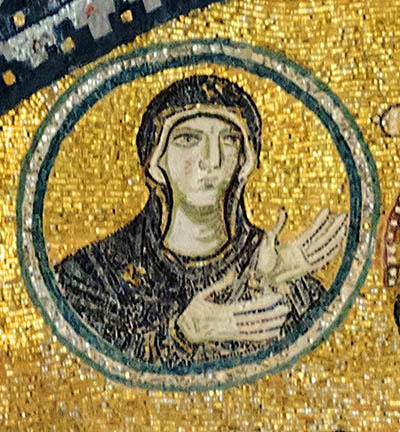 The flesh tones of the face and neck of the Virgin are of pale pink and blue-white marble. The color is heightened in the cheeks by short lines of two or three tesserae of rather dull orange-vermilion glass and shadowed by light green and yellow glasses. The forehead and right side of the face, the chin and neck are outlined in light transparent glass, and from this short lines of the same material also merge with the green shadow on the side of the face and around that side of the neck. The face has a very washed-out, pallid appearance; this condition is further discussed in the description of the archangel and elsewhere below.
The flesh tones of the face and neck of the Virgin are of pale pink and blue-white marble. The color is heightened in the cheeks by short lines of two or three tesserae of rather dull orange-vermilion glass and shadowed by light green and yellow glasses. The forehead and right side of the face, the chin and neck are outlined in light transparent glass, and from this short lines of the same material also merge with the green shadow on the side of the face and around that side of the neck. The face has a very washed-out, pallid appearance; this condition is further discussed in the description of the archangel and elsewhere below.
The pupils of the eyes, the upper lashes, and the eyebrows are black. The irises are of light purple and the whites of limestone except for the inner side of the right eye which is pale green. The lower lashes and the upper lids are of light transparent glass.
The shadow line down the length of the nose, the side of the right nostril, and the lighter shadows just below the nose and between and under the lips are in light transparent glass. The darker shadows below the nose and on each side and below the lips are in dark blue, which also gives the darkest point of shadow on each cheek.
The whole of the face and neck are outlined by a single strong line of clear brown glass. The edge of the bonnet is in white limestone with a shadow line of light green broken here and there by single white tesserae.
The Virgin's robes are in dull blue glass used in two values with outlines and shadow lines in clear brown glass. A single line of gold edges the blue maphorion around the face and neck. On Her right shoulder is a gold star formed of four blocks, each of four tesserae. Two lines of gold are shown at the left wrist and three on the right where the cuff of the chiton protrudes from the maphorion which otherwise completely covers what is seen of the body. A star formed of four gold tesserae is on the right cuff.
The hands are of white, cream, and pink stone and marble shadowed by light green glass. The under sides of the fingers of the left hand are of clear brown, dark translucent glass while the line across the base of the fingers and the two lines dividing the palm and defining the ball of the thumb are of light transparent glass. The lower outlines of the third and fourth fingers of the right hand and across the wrist and at the base of the thumb are of clear brown glass. Those between the second and third fingers and below the lower joint of the thumb are deep red. In each hand the first finger is held independently and the other three are grouped together.
Medallion with Archangel
The medallion on the right-hand side is framed in a border formed by a single row of deep red glass, a row of silver set at an angle, amongst which are a few gold tesserae, and three rows of dark blue glass. The background is of gold, with some silver tesserae, set at an angle in horizontal rows.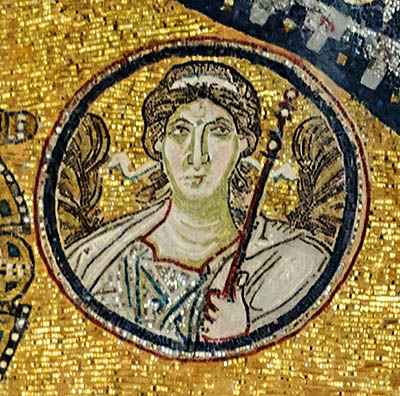
The flesh tones of the face and neck of the archangel are of the pale, mid pink, and blue-white marbles. The shadows are of light green and yellow-green glass. The pupils of the eyes, the upper lashes, and the inner parts of the eyebrows are purple-black, which also renders the spots of shadow beneath each nostril and at the sides of the parting of the lips. The irises, the lower lids, and the outer ends of the eyebrows, the darker shadows above the eyes, down the right side of the nose, beside each nostril, and above the lips are purple. The whites of the eyes were of limestone on the left sides and there is a single green on the right of each. All the white tesserae have been lost from the left eye.
The upper lip is of cream marble and the lower of the same material with some deep red glass on the left side and along the lower edge. The pale marble used in the lips and three similar tesserae along the lower side of the tip of the nose lend an unnatural pallor to the face. The contrast between these and the deep red glass used in the lower lip points forcibly to the almost certain probability that the pale tesserae were originally coated with bright red pigment which has been entirely eroded from the surface. It is interesting to compare glass is used this head with that of the emperor in whose face orange-vermilion at these points.
The neck line against the robes is a strong line of deep red glass. The outline of the top of the head is a row of dark blue. The hair is of purple glass lit by gold and shadowed by purple-black and clear brown glass. On each side of the neck, however, the hair is made with metallic tesserae set variously: in reverse to give mat brown or soft purple grey, and on one side for dark clear brown from the gold tesserae or to exploit the light transparent glass used for the silver. The few shadow lines at the sides are in purple-black.
A white fillet is bound around the head and the free ends of the ribbon wave on each side of the face. This is of white limestone shadowed by turquoise blue. A part only of the left hand is shown. The flesh tones are of pale pink and blue-white marble. The outlines of the three fingers and of the inner side of the thumb are of deep red glass which also outlines the back of the hand against the frame of the medallion below. The whole of the silhouette of the hand is outlined in mat brown, the dark earth-red of the bases of large gold tesserae being set in reverse. The archangel holds a staff which is drawn with two single lines of glass tesserae; deep red on the left and dark blue on the right. Just above the tip of the thumb is an orange-vermilion tessera among the red.
The wings are of matte brown lit by gold and light green glass with shadow lines of dark clear brown.
The archangel wears a chiton of white with high lights of silver set at an angle. Shadow lines are of turquoise blue, yellow-green and light translucent glass. A himation hangs over the shoulders; this is of grey Proconnesian marble lit with white limestone and with shadow lines of light and clear brown translucent glass.
The Emperor
The halo of the emperor is outlined with a double row of dark blue. It is filled with gold set at an angle in horizontal rows. Only a few silver tesserae are mixed with the gold, in marked contrast to the high proportion used in the surrounding background.
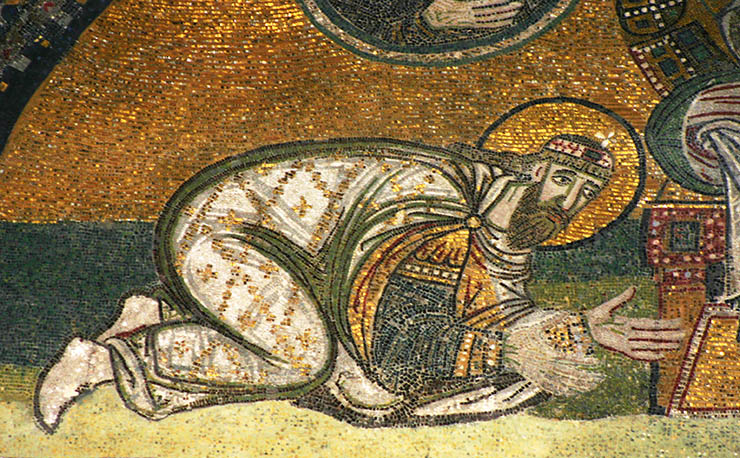 The flesh tones of the face and neck are of white and pale pink marble shadowed with yellow-green glass. The eyebrows are of dark, clear brown glass. The pupils and upper lashes of the eyes are of purple-black. The irises and lower lashes are of light purple and the shadows below the eyes of light green-amber. The whites of the eyes are of limestone.
The flesh tones of the face and neck are of white and pale pink marble shadowed with yellow-green glass. The eyebrows are of dark, clear brown glass. The pupils and upper lashes of the eyes are of purple-black. The irises and lower lashes are of light purple and the shadows below the eyes of light green-amber. The whites of the eyes are of limestone.
The shadow at the center of the ear is given by a line of deep red glass. The shadow lines below the eyebrows and down the length of the right side of the nose, around the side of the nostril, and at the sides of the face are light purple.
A row of three orange-vermilion tesserae indicate the reflected light below the tip of the nose. The beard is light purple and light transparent glass shadowed by darker glass and lit by yellow-green below the mouth. The lips are of orange-vermilion glass with the parting in dark purple.
The emperor's hair, hanging down his back, is drawn and shadowed in dark, clear brown glass, with some of mat brown, and lit by yellow-green and light transparent glass. The rest of the hair is in dark, clear brown glass and the fringe around the forehead is lit by short vertical strokes of yellow and yellow-green.
The crown is drawn with light and dark clear glass. The cross of pearls on top was of four drop-shaped pieces of limestone with a smaller circular piece set to the left of the center. Only two of the drop-shaped stones survive. Around the crown pearls are set two deep in a band of dark red, with a rectangular emerald green jewel outlined in dark blue over the forehead; only two of the four green tesserae survive.
The emperor wears a divitision with full sleeves. It is turquoise blue with dark blue shadow lines and high lights of silver. Two gold bands set with pearls form the right cuff. One band only is seen on the left. A gold shoulder piece is drawn with horizontal rows of tesserae set at an angle and edged below with scallops of dark, clear brown glass; vertical strokes of deep red indicate the shadowed folds. Beneath this epaulet is a band around the arm of light transparent glass set with pearls and bordered by single rows of gold set at an angle with a line of dark clear glass below.
Over the divitision the emperor wears a chlamys which covers the rest of his body. This is of white limestone with light shadowed folds of grey Proconnesian marble and deeper shadows of light green glass. The outlines shadow lines of the himation are of dark, clear brown with some matte brown, especially in the folds below. On the right shoulder center of a of shadowed right radiating group folds is a circular fibula. A patch of unset plaster, intended no doubt to represent a pearl, is surrounded by gold tesserae set a an angle and by a ring of dark clear glass. A diaper pattern of gold lines with gold crosses set in the centers of the white panels decorates the outer surface of the chlamys. The lining is of gold with deep red shadow lines. All the gold in this garment is set at an angle.
The flesh tones of the left hand are of white and light pink marble with yellow-green to indicate the lines on the palm. The underside of the hand, fingers, and thumb are outlined with deep red glass. The right hand is of pale pink and cream colored marble and white Proconnesian marble. The shadow lines at the wrist are of yellow-green glass.
The tesserae in the hands are set widely apart and in the unset plaster can be seen the incised lines of the cartoon drawing of the hand and of the end of the the lunette.
The soles of the emperor's buskins are outlined with dark, clear brown glass. The ankle of the right buskin is decorated with a double row of pearls. On the toe and heel are groups of white limestone tesserae which are also spaced upon the instep, apparently to represent lacing. At the back of the heel is a single deep red glass tessera, and deep red shadows the upper part of the foot which is turned downward. The remainder of the surface is of blue-white marble. The heel of the left buskin has a large group of white limestone tesserae which are also spaced around the base of the ankle. Again deep red tesserae shadow the instep, but the rest is set with blue-white marble.
The white limestone tesserae are larger than those of blue-white marble which, in places on both feet, bear traces of vermilion pigment. This pigment also survives on the face of the setting-bed between the tesserae. It is evident that the buskins were originally vermilion, but it is possible that their paint, as well as that of the cushion, was renewed on the surface at some later time. As in the other areas where the process of coating tesserae with pigment before insertion was employed, it is only by postulating that these blue-white tesserae were originally treated in some such manner that these passages can be explained. When this is understood it is clear that the white limestone represents pearls and lacing and high lights on the heels and toes, with the deep red glass used to give depth of color in the shadowed areas.
Of the surviving mosaics in St. Sophia only the figures of the Virgin and Child and the archangel in the apse and this panel were without inscriptions when made. In 1960 the removal of nineteenth-century plaster patches from the background on either side of the halo of Christ revealed that the inscription IC XC had existed, but it was an insertion of a later period. The letters are .19 m. high and fill the space between the halo and the back rail and finials of the throne overcrowding the composition. The forms of the letters and abbreviation signs were cut out from the setting-bed plaster of the gold background and filled with beeswax into which glass tesserae were embedded. Only small pieces of wax bearing impressions of the fragmented pieces of glass were found. These tesserae of average size, but all are lost and no indication of the color exists. There is scant evidence for dating the insertion but the possibility that the bright red paint was touched up, as it may have been in the apse mosaics, in the eleventh century, prompts the suggestion that the siglae were also made at this time, when, it may be noticed, the use of such inscriptions on the coinage had become general.
OBSERVATIONS
This panel is not unique for the use of tesserae coated with pigment. The practice has been observed in mosaics from as early as the fourth century at Centcelles and onward, including those of Kanakaria and Kiti. It has been found in the mosaics of St. Sophia, however, only in those which are dated to the ninth and tenth centuries, with the sole exception of the rather crude use of marble tesserae in the fourteenth-century repair of the east side of the dome. In the narthex panel the use of such tesserae was extensive and pervaded most of the main features of the The The almost total loss of red pigment from the surface must, therefore, be taken into consideration when any attempt is made to visualize its original appearance. The use of comparatively large areas of the brilliant vermilion type of red is less when the use of surprising unusually strong the deep red and a contrasting colors of the other glass tesserae in the head of Christ is borne in mind. The effect is somewhat strident and a sharp reminder of the use of pungent color which was so frequently employed in mediaeval decoration. Whether this is to be accounted a characteristic of its period or as an idiosyncrasy of the artist must remain an open question, perhaps until a precise date can be more confidently attributed. But a factor possibly overruling either of these considerations is the situation of the lunette high up in the narrow corridor of the narthex. It was lit only by the semicircular window facing it at the same height and little light was to be reflected from the floor in spite of the huge doorways below and on the opposite side because both, even when open, were shrouded by heavy curtains suspended from bronze hooks in the form of fingers, which are still in situ and are of sixth-century origin.
There can be no doubt that red, a primary color which dominates many compositions, presented a problem to the artists of Constantinople working in mosaic. Only two red glasses were available: deep red and the bright red, orange-vermilion; both opaque with no gradations in tone such as are to be found freely employed in blue, purple, and green. The range of reds was extended by the introduction of pink marble, sometimes in three values, occasionally by earth-red stone and frequently by the use of pieces of terra-cotta. It is to be observed that in the smaller scale mosaics of the fourteenth century in the Kariye Camii and Fethiye Camii the lighter tones of red were rendered by terra-cotta for the middle, and by pink marble for the lightest tones.
The use of the bright red paint to coat tesserae presents an interesting problem in association with the orange-vermilion glass - No. 4 in the color chart-the use of which was very restricted in Constantinople. Although this glass appears in several of the mosaics of St. Sophia, its use is exceptional and the manner in which it is handled usually so restrained that the total number of tesserae of this color in the surviving mosaics of the city could be counted without difficulty. It is found only in figure compositions which are of the ninth and tenth centuries, with the sole exceptions of a group of tesserae used to represent the cover of a gospel held by the central figure, of uncertain date, in the north apsidiole of the chapel in the southwest buttress of St. Sophia and of a few tesserae used very sparsely in the faces of some of the Prophets high in the dome of the small chapel at Fethiye Camii, though nowhere else in the fourteenth-century mosaics of that building and not at all in those of the Kariye Camii. It is indeed strange that glass of this attractive and useful color should have been so rarely employed here-for the most part only during a limited period and then alternatively with the bright red paint, sometimes in the same panel-while in Italy it seems to have been used freely at all periods. It occurs also in late Roman floor mosaics, too numerous to cite, over widely distributed areas of the Mediterranean. The translucent glasses, blue, green, and purple, were all made in a gradation of intensities from which it was possible to select a limited range of values to use individually, for it must be appreciated that there was no rigid series of tones. With the opaque red glass this was not so and the artist was confronted by an absence of material of similar nature and texture to depict the lighter tones. The bright red, orange-vermilion glass would have provided a variation of color and the evident scarcity of this was remedied in this panel by the use of the orange-red pigment, minium, close to vermilion in color, easily and cheaply made, and much employed throughout the middle ages for the embellishment of manuscripts.
A rational appraisal of the choice of tesserae and of their setting in the narthex mosaic confirms that the work was executed with verve and spontaneity, in a spirit of improvisation not consonant with the rigidly controlled method of procedure which it has become fashionable to attribute to Byzantine artists.
The gold background has a shimmering effect at most times of the day and this is because the tesserae were set with the free hand of a well practiced artist- craftsman who tilted the metallic faces slightly downward. The intention was certainly to reflect light to the eye of the spectator, but the setting of the surfaces at angles ranging from 9 to 26 degrees from the perpendicular does not indicate any attempt to compute an exact angle of reflection for viewing the lunette from an optimum distance. The mean of the angles of the majority, which are between 9 to 15 degrees, does indeed give the best result for an observer standing beneath the opposite doorway, which, in this case, within the narrow limits of the narthex, is the only position from which the lunette can be seen at all well.
This descriptive text on the mosaic above is from Further Observations on the Narthex Mosaic in St. Sophia at Istanbul Author: Ernest J. W. Hawkins
Bob Atchison
```
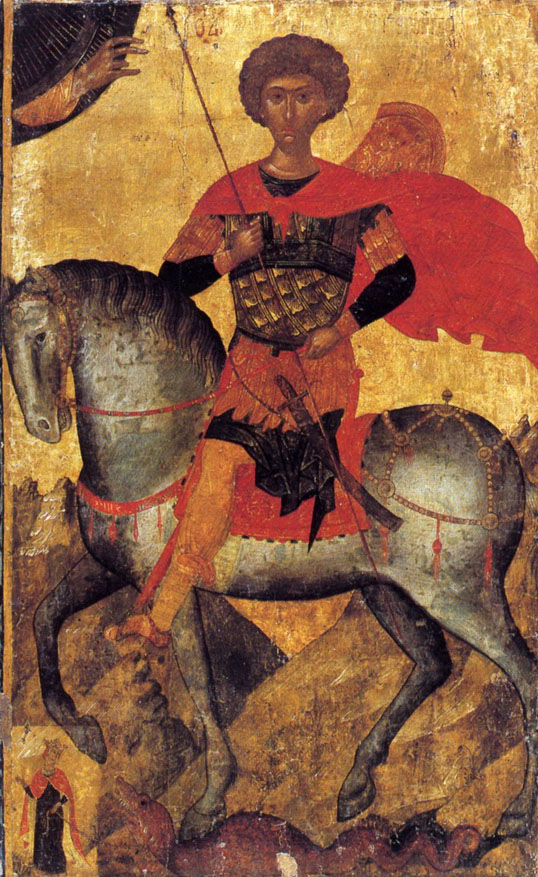
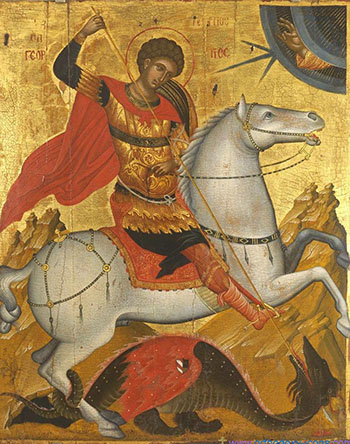
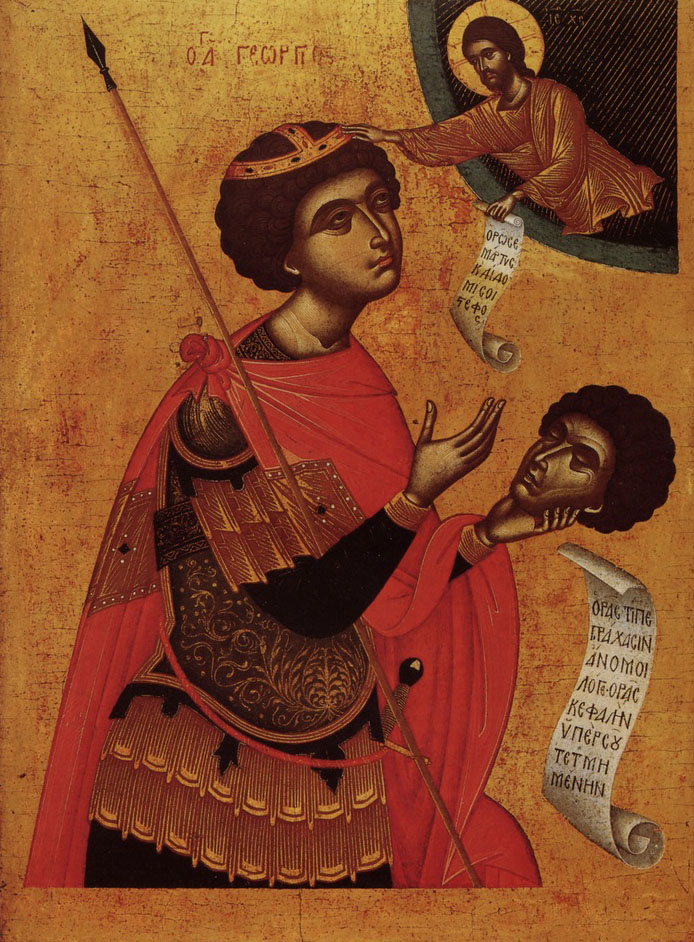
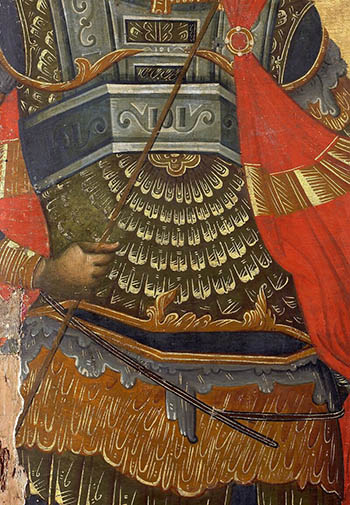
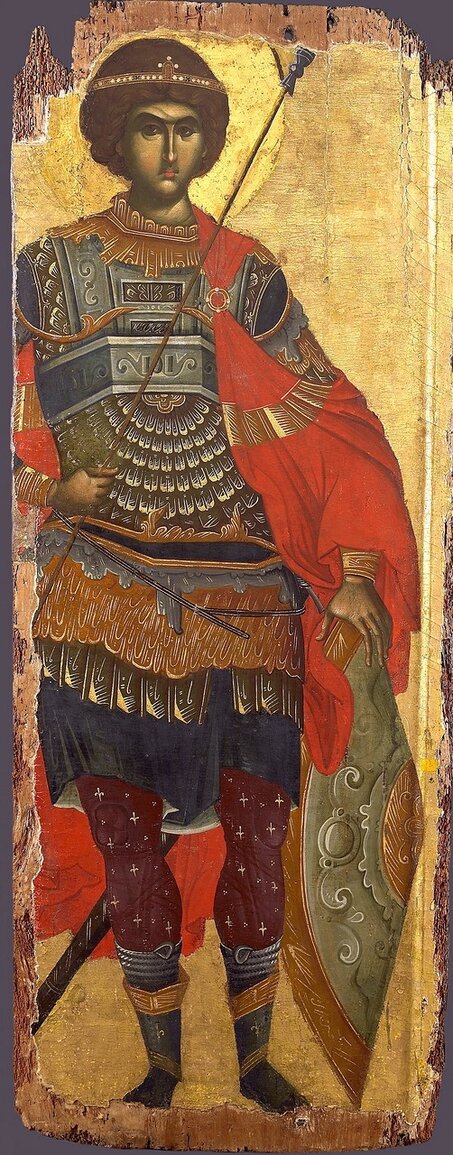
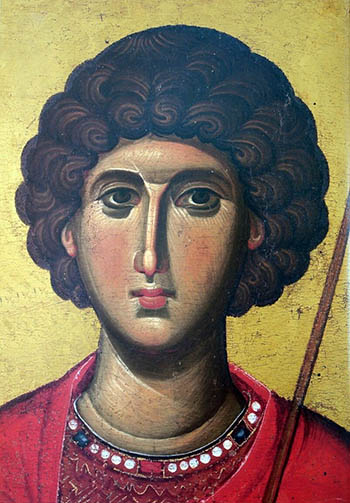
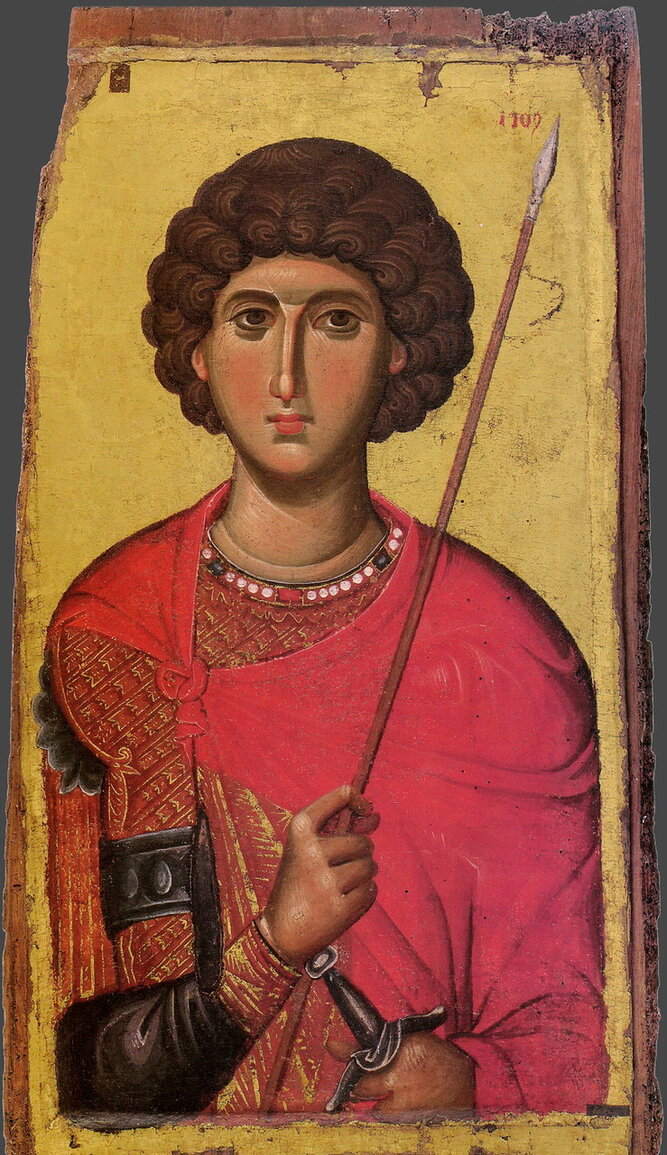
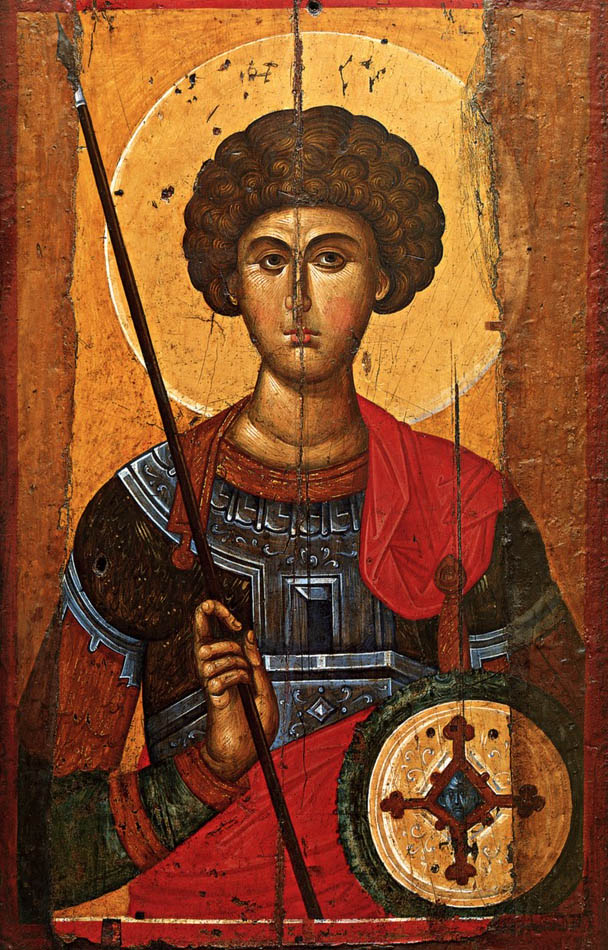
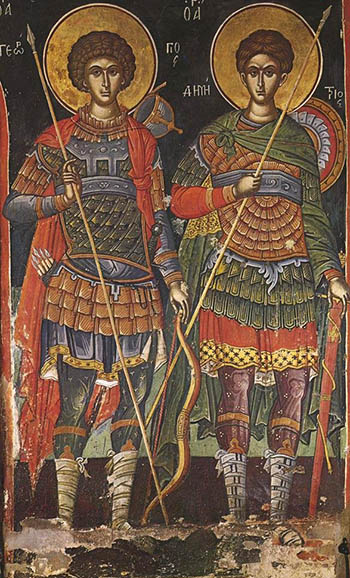

 Leo VI was called the Wise for his completion of the compilation of a great law code in Greek for the empire, called the Basilika. He was the second son of the previous emperor, Basil I and Eudokia Ingerina. Leo was actually the son of the precious emperor Michael the Drunkard, which is a long story best told in its own page. Basil knew Leo was not his son; Leo also knew who his real father was.. As result, Basil treated him badly; he favored his first, natural son, Constantine, over Leo. Even though Basil had Constantine and Leo crowned as co-emperors, he excluded Leo from any role in government or the military. He finally shut Leo up in captivity within the palace grounds.
Leo VI was called the Wise for his completion of the compilation of a great law code in Greek for the empire, called the Basilika. He was the second son of the previous emperor, Basil I and Eudokia Ingerina. Leo was actually the son of the precious emperor Michael the Drunkard, which is a long story best told in its own page. Basil knew Leo was not his son; Leo also knew who his real father was.. As result, Basil treated him badly; he favored his first, natural son, Constantine, over Leo. Even though Basil had Constantine and Leo crowned as co-emperors, he excluded Leo from any role in government or the military. He finally shut Leo up in captivity within the palace grounds. Alas for Basil, his favorite Constantine died and he was compelled to release Leo from prison due to public pressure and a guilty conscience. Basil was hosting a banquet in the palace for a group of senators. During the dinner a palace parrot - a favorite and very popular bird - who had been kept in a cage near Basil started screeching "Poor Leo, Poor Leo, let him go", over and over again! No one knew where the parrot learned to say it and his words were considered an omen. The senators pleaded with Basil to take pity on Leo. Basil released Leo in June and three months later in, September 866, Basil was dead! Happy Leo, poor Basil. There is no record of what happened to the parrot, one can hope Leo rewarded him for his intervention on Leo's behalf when he became sole emperor. Below is a manuscript illustration of the incident of the parrot, probably a green Indian ringneck parakeet, which was very popular in Byzantium as a pet. They were recognized for their ability to clearly mimic human language were admired for their colors and charming disposition, but the church discouraged excessive attention being given to pets like birds. Clement of Alexandria rebuked people who kept parrots, apes, and peacocks to amuse them at dinner, instead of providing for the poor. On can only imagine Imperial dinners with apes!
Alas for Basil, his favorite Constantine died and he was compelled to release Leo from prison due to public pressure and a guilty conscience. Basil was hosting a banquet in the palace for a group of senators. During the dinner a palace parrot - a favorite and very popular bird - who had been kept in a cage near Basil started screeching "Poor Leo, Poor Leo, let him go", over and over again! No one knew where the parrot learned to say it and his words were considered an omen. The senators pleaded with Basil to take pity on Leo. Basil released Leo in June and three months later in, September 866, Basil was dead! Happy Leo, poor Basil. There is no record of what happened to the parrot, one can hope Leo rewarded him for his intervention on Leo's behalf when he became sole emperor. Below is a manuscript illustration of the incident of the parrot, probably a green Indian ringneck parakeet, which was very popular in Byzantium as a pet. They were recognized for their ability to clearly mimic human language were admired for their colors and charming disposition, but the church discouraged excessive attention being given to pets like birds. Clement of Alexandria rebuked people who kept parrots, apes, and peacocks to amuse them at dinner, instead of providing for the poor. On can only imagine Imperial dinners with apes!

 In 1959 and 1960 further cleaning was done on the mosaic over the Imperial Door, the great doorway leading from the narthex into the nave, of St. Sophia at Istanbul. This completed the work done in 1931-1932 which, as Thomas Whittemore reported, left the mosaic somewhat obscured by plaster remaining from its having been covered, in 1847-1849, under the direction of the Fossati brothers. The removal of this nineteenth-century plaster, and of some paint also on the surface, has allowed for more precise observations of the panel which revealed details of the mosaic, such as the feet of Christ, the finial on the left-hand side of the horizontal bar across the back of the throne, the knot on the right-hand side of the cushion, asymmetrical arrangement of the cross of pearls on the Emperor's crown, and an inserted inscription. It is now possible to make a restatement of the materials and colors employed and thus to explain the present pallid appearance of the faces of the Virgin and the Archangel in the medallions, to clarify the design at the central part of the drapery where the robes of Christ have been confused with the fabric of the cushion, and to confirm the statements of Salzenberg and Labarte that the buskins of the Emperor were red.
In 1959 and 1960 further cleaning was done on the mosaic over the Imperial Door, the great doorway leading from the narthex into the nave, of St. Sophia at Istanbul. This completed the work done in 1931-1932 which, as Thomas Whittemore reported, left the mosaic somewhat obscured by plaster remaining from its having been covered, in 1847-1849, under the direction of the Fossati brothers. The removal of this nineteenth-century plaster, and of some paint also on the surface, has allowed for more precise observations of the panel which revealed details of the mosaic, such as the feet of Christ, the finial on the left-hand side of the horizontal bar across the back of the throne, the knot on the right-hand side of the cushion, asymmetrical arrangement of the cross of pearls on the Emperor's crown, and an inserted inscription. It is now possible to make a restatement of the materials and colors employed and thus to explain the present pallid appearance of the faces of the Virgin and the Archangel in the medallions, to clarify the design at the central part of the drapery where the robes of Christ have been confused with the fabric of the cushion, and to confirm the statements of Salzenberg and Labarte that the buskins of the Emperor were red.




 The face is unusual amongst the mosaics of St. Sophia in that it is executed in a broad manner with strong contrasting groups of green and flesh colored tesserae. At close quarters the dominant characteristics are the contrasts between the white high lights and he black shadow lines of the hair and beard, and between the red lights of the hair - echoed in the shadow lines over the eyes and in the beard below the sides of the mouth - and the bright green shading of the flesh. These strong and vivid contrasts impart a considerable feeling of projection to the features; indeed the head is conceived with a keen sense of the forward contours.
The face is unusual amongst the mosaics of St. Sophia in that it is executed in a broad manner with strong contrasting groups of green and flesh colored tesserae. At close quarters the dominant characteristics are the contrasts between the white high lights and he black shadow lines of the hair and beard, and between the red lights of the hair - echoed in the shadow lines over the eyes and in the beard below the sides of the mouth - and the bright green shading of the flesh. These strong and vivid contrasts impart a considerable feeling of projection to the features; indeed the head is conceived with a keen sense of the forward contours. The flesh tones of the face and neck of the Virgin are of pale pink and blue-white marble. The color is heightened in the cheeks by short lines of two or three tesserae of rather dull orange-vermilion glass and shadowed by light green and yellow glasses. The forehead and right side of the face, the chin and neck are outlined in light transparent glass, and from this short lines of the same material also merge with the green shadow on the side of the face and around that side of the neck. The face has a very washed-out, pallid appearance; this condition is further discussed in the description of the archangel and elsewhere below.
The flesh tones of the face and neck of the Virgin are of pale pink and blue-white marble. The color is heightened in the cheeks by short lines of two or three tesserae of rather dull orange-vermilion glass and shadowed by light green and yellow glasses. The forehead and right side of the face, the chin and neck are outlined in light transparent glass, and from this short lines of the same material also merge with the green shadow on the side of the face and around that side of the neck. The face has a very washed-out, pallid appearance; this condition is further discussed in the description of the archangel and elsewhere below.
 The flesh tones of the face and neck are of white and pale pink marble shadowed with yellow-green glass. The eyebrows are of dark, clear brown glass. The pupils and upper lashes of the eyes are of purple-black. The irises and lower lashes are of light purple and the shadows below the eyes of light green-amber. The whites of the eyes are of limestone.
The flesh tones of the face and neck are of white and pale pink marble shadowed with yellow-green glass. The eyebrows are of dark, clear brown glass. The pupils and upper lashes of the eyes are of purple-black. The irises and lower lashes are of light purple and the shadows below the eyes of light green-amber. The whites of the eyes are of limestone.




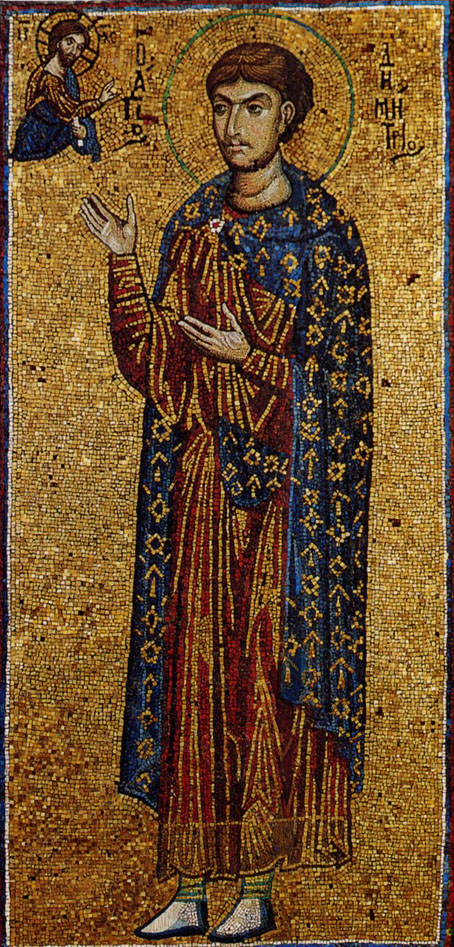
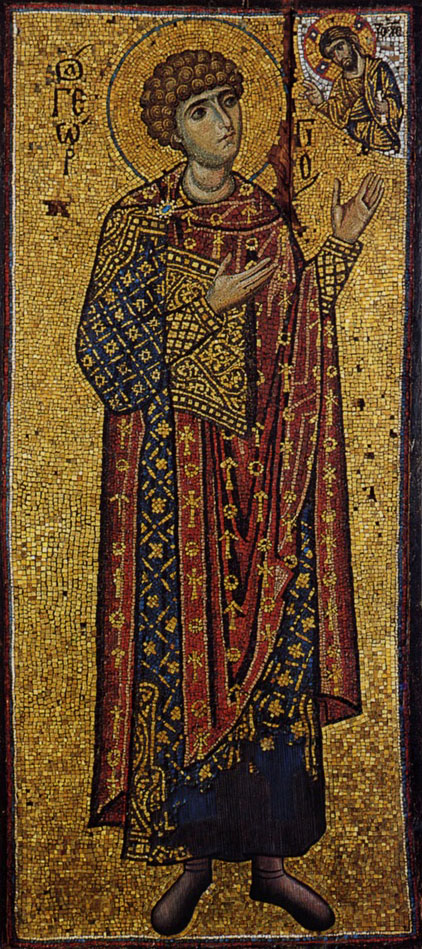
 click here for icons of christ
click here for icons of christ click here for icons of the theotokos
click here for icons of the theotokos click here for icons of angels
click here for icons of angels click here for icons of saints
click here for icons of saints








